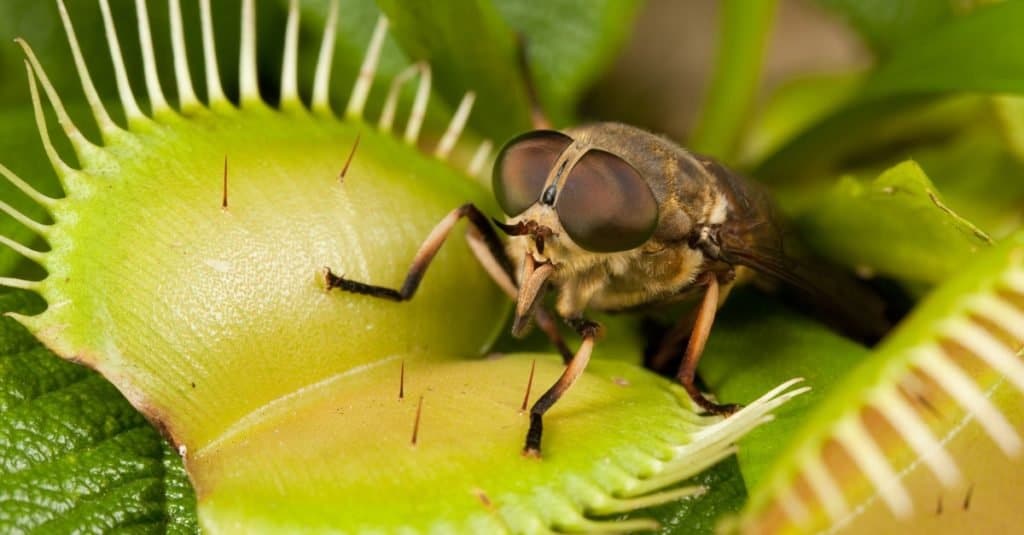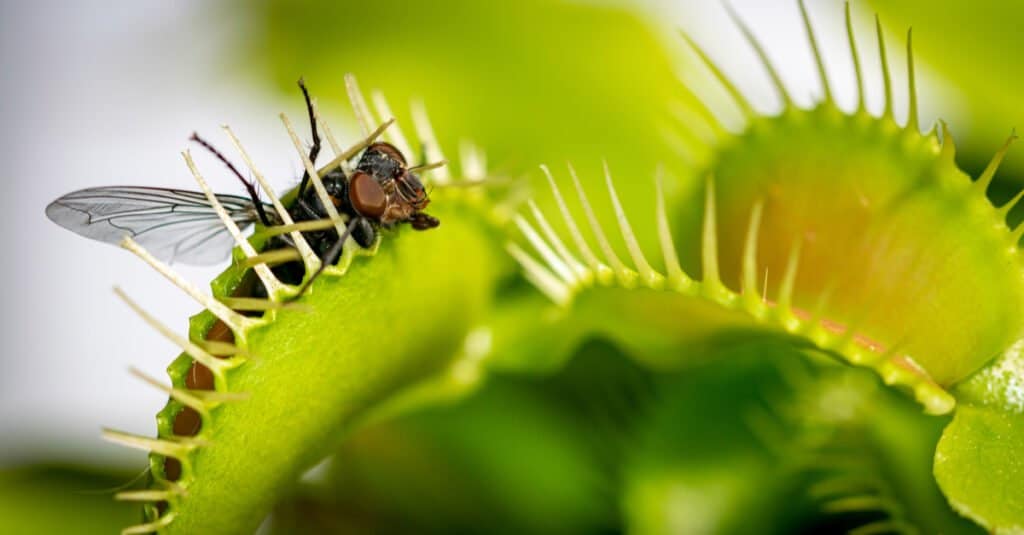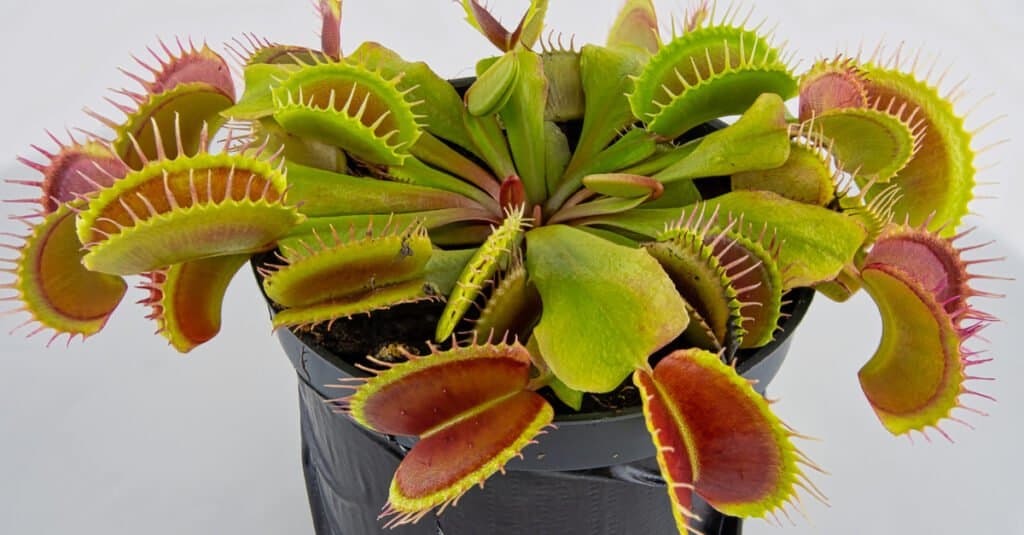What Kind of Bugs Do You Feed a Venus Fly Trap
Venus flytraps are famously known for their exciting, sometimes horrifying method of feeding. Have a fly problem? Get a Venus flytrap! But are Venus flytraps really all they're made out to be? And just what do Venus flytraps eat, and how?
Here, we'll learn more about what makes Venus flytraps tick, starting with a few of their favorite foods. We'll explore what Venus flytraps eat in the wild, what their carnivorous relatives eat, and how they eat it. Then, we'll go over the care and feeding of pet Venus flytraps. Finally, we'll answer that age-old question; do Venus flytraps work at home?
What Do Venus Flytraps Eat?

Linas T/Shutterstock.com
Venus flytraps eat primarily crawling bugs like ants, spiders, and beetles. They are carnivores.
Venus flytraps are native to the east coast of the United States, specifically boggy, coastal areas in North and South Carolina. Locally they are also called 'meadow clams' because of their ground dwelling nature and mollusk-like appearance.
Because Venus flytraps live in such poor soil, they have to derive nutrients like nitrogen, phosphorous, and sodium from other sources; namely, bugs.
The Venus flytrap eats just about any insect that gets stuck in its 'mouth'—as long as that insect is the right size, and struggles enough to stimulate feeding.
The diet of the wild Venus flytrap includes:
- Spiders
- Ants
- Beetles
- Grasshoppers
- Flies
The key factor in prey selection for the Venus flytrap is size. They will often let very small insects go because it takes more energy to digest them then they're worth. Venus flytraps do this by closing their 'mouth' partially at first, giving the too-small bugs a chance to escape.
Venus flytraps do not generally eat earthworms; they are too big and not likely to crawl into the plant's 'mouth'. They prefer crawling insects, which are easier to trap, but will eat flies and other flying insects if they get the chance.
How Do Venus Flytraps Eat?

josehidalgo87/Shutterstock.com
Venus flytraps have one of the most interesting feeding mechanisms in the animal (and plant) kingdom. Like most flowering perennials, they have both flowers and leaves. What's unique about the Venus flytrap is that its leaves actually split at the ends, forming two lobes that resemble a bright pink, open mouth. The edge of each lobe is lined with stiff cilia resembling spiky teeth that lock together when the 'mouth' closes.
Inside the lobes, the Venus flytrap has six 'trigger hairs', three on each lobe. When an insect makes the mistake of walking across these hairs, the 'mouth' snaps shut, trapping the prey.
The Venus flytrap has developed means of differentiating between things like leaves and raindrops and things that are good to eat—like bugs. It will only snap shut (which takes about half a second) if two or more of the trigger hairs are triggered.
Once the mouth snaps shut, the prey is effectively stuck. The two lobes seal together and create a 'stomach'. Then, the Venus flytrap releases digestive enzymes and, over the course of 4-10 days, digests the insect and absorbs its nutrients. At the end, the Venus flytrap's lobes open back up, and the remaining hard exoskeleton of the insect blows away.
Other Carnivorous Plants and Their Diets
Venus flytraps may be the most famous of the carnivorous plants, but they are not alone in their insect eating habits.
Venus flytraps belong to the sundew family (Droseraceae) which includes 152 species of carnivorous plants. Carnivorous plants can be found in nutrient poor soil in tropical and temperate areas all over the world, particularly in boggy regions in Australia.
Other members of the sundew family, rather than trapping their prey using 'rapid plant motion' like the Venus flytrap, utilize sticky pads. Sundew plants eat the same diet of insects that Venus flytraps rely on. When insects crawl over, or land on, the sticky pads, they become trapped. The sundew plant then curls over the insect and slowly digests it, uncurling when it is done.
Another type of carnivorous plant is the pitcher plant, so named because some varieties of this plant resemble a drink pitcher. These plants are not in the sundew family, but they are carnivorous, and even eat small rodents, salamanders, and newts. They operate by luring creatures into their bell or tube shaped leaves. The inner walls are very smooth, making it impossible for the prey to escape. A pool of digestive juices at the bottom of the concave leaf drown and then digest the unfortunate prey.
What to Feed Your Pet Venus Flytrap

Craig Russell/Shutterstock.com
Venus flytraps are a popular household plant. But just what should you feed your Venus flytrap?
Well, the answer may surprise you. The health of your Venus flytrap is actually much more dependent on how you keep it. Venus flytraps need warm, moist environments, and often do best in high humidity terrariums. They cannot survive freezing temperatures, but do have a high tolerance for standing water.
Once you've given your Venus flytrap a nice home, you'll want to feed it. Venus flytraps only need to be fed about twice a month, less during the winter months. Frozen or dried crickets, mealworms, or blood worms are the best options. Blood worms are most often fed to fish, but with a little rehydration they make the perfect meal for your Venus flytrap.
Do Venus Flytraps Work At Home?
Many people buy Venus flytraps for home insect control. But, Venus flytraps eat crawling insects, like ants and spiders, and have a hard time catching fast bugs like flies. So, if you're thinking of buying a Venus flytrap to catch the flies in your house, you may want to look for alternatives.
Venus flytraps may not make the perfect flycatchers, but if you're a fan of the unique toothed lobes, bright pink mouth, and snap-shut motion of a carnivorous plant on the hunt, then a Venus flytrap may be the right plant for you.
Thank you for reading! Have some feedback for us? Contact the AZ Animals editorial team.
Source: https://a-z-animals.com/blog/what-do-venus-flytraps-eat-5-favorite-foods/
0 Response to "What Kind of Bugs Do You Feed a Venus Fly Trap"
Post a Comment